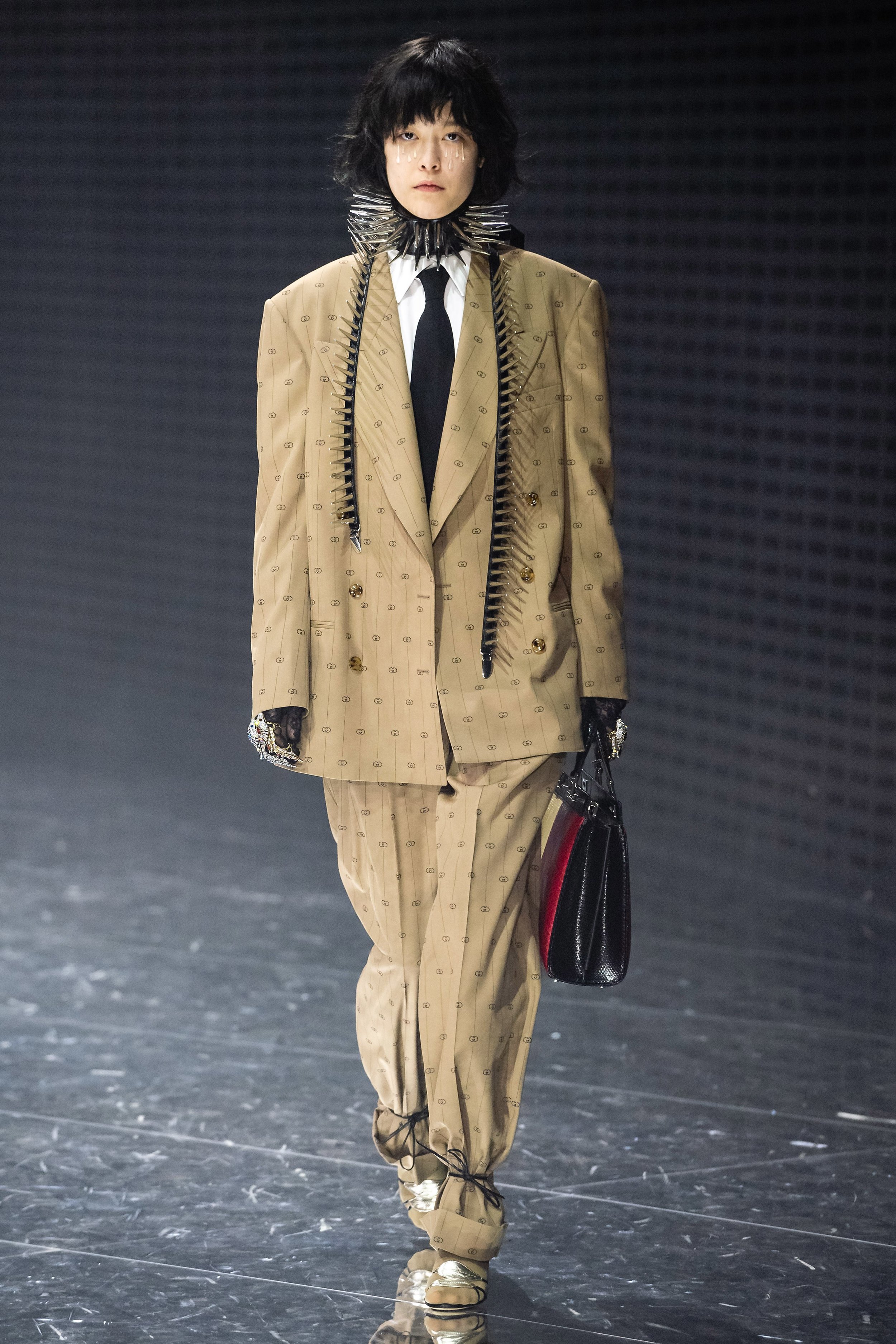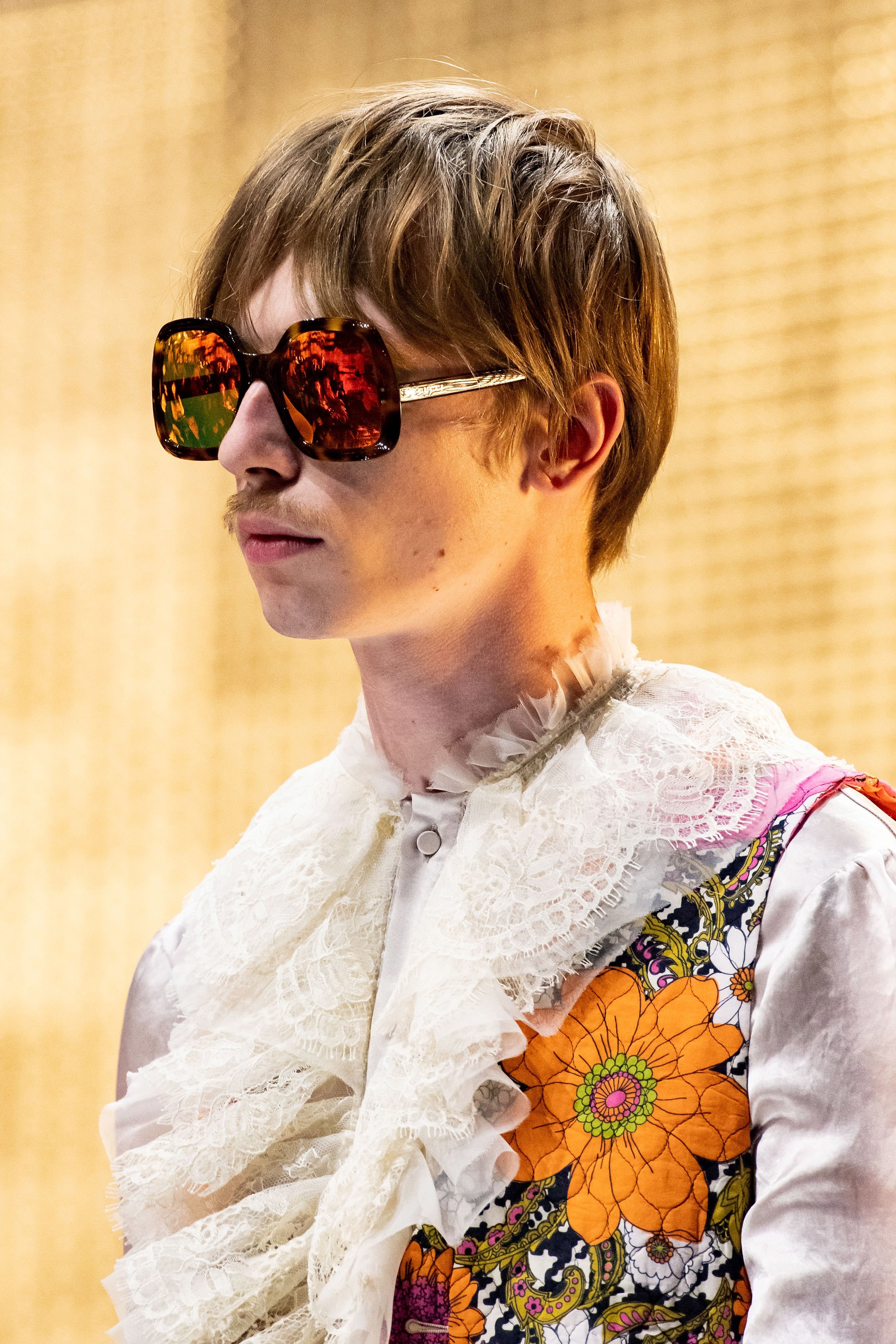Is gender-specific fashion no longer relevant?
Header Image: Palomo Spain A/W17Photography by Noel Quintela, Courtesy of Palomo Spain. Available from: http://www.anothermag.com/fashion-beauty/9644/the-spanish-designer-subverting-gender-stereotypes
Thumbnail Image from: Armando Grillo / Gorunway.com. Gucci Fall 2019 Ready-to-Wear. Available from: https://www.vogue.com/fashion-shows/fall-2019-ready-to-wear/gucci/slideshow/details#84
By Hannah Schmidt-Rees
Gender and fashion are inherently linked. Something as simple as the layer of material between our bodies and the outside world can generate assumptions, answer questions and create an intimate sense of self-identity. The fashion we wear, the styles we follow; whether we know it or not; are a powerful means of communication about our social status, identity, sexuality, political views, religious inclinations, gender, profession and lifestyle. (Read more about the importance of fashion in our social image here).
Let me make something clear, whilst a person's sex is their biology, their gender is simply a societal and cultural construct. As an example, there is a big difference between being female and being 'feminine'. Gender; the visual and personality traits associated with male and female; are nothing more than a subjective concept. Females are not more emotional than males. They're only raised to be more accepting of their own emotions. Males are not less focused on their looks than women. They’ve just been told that caring about the way they look is effeminate, and therefore negative and incorrect. Male and female children are brought up to follow a specific set of rules that are restrictive and simply made up.
It's not always known, but the link between gender and fashion hasn’t always existed. It's only been around for about 400 years. Even the concept of dressing baby girls in pink and baby boys in blue, a concept so widely known and overused today, originated in the 1940s by marketers and advertisers (as 'individualised' clothing sells more).
So how did this link start? Get ready for a quick-fire lesson in the history of gender and fashion.
It was the 1650's when western fashion became a tool to separate men and women. Previously, the purpose of fashion was to show status and social class. Both men and women wore elaborate costumes, embellished with bold colours and silhouettes that would only dictate an individual's social standing when at an event. The higher the class, the more elaborate the costume. The aristocratic and bourgeoisie classes wore perfume, silk, wigs, excessive hats, velvet and lace; without any gender restrictions.
In the years later, the 'great male abandonment' (as described by John Flugel in 1930), resulted in men's clothing becoming more muted and minimalist, whilst women's clothing stayed elaborate and beautiful. Menswear became less focused on looks and status, and more about usefulness. Especially in the Victorian period, men became more focused on politics and business, leaving the demonstration of social status to the women. This is when gender became a bigger determining force in fashion than social class, and is also the birth of women being the 'fashionable' gender.
“Fashion distorted the natural body through subordinating practices like high-heels, corsets and objectifying fashions that reduced women to objects of a sexualising gaze, rendering them unable to act effectively in the world. It diverted women’s energies into trivial questions of appearance; and reinforced negative stereotypes of women as ever-changing, inconstant and narcissistic.”
Fast forward to the 1920s, and the emancipation of women brought upon a significant wave of gender deconstruction in fashion. Trousers for women were created, however only tolerated in sports and leisure activities. It also should be mentioned that that in 1923, Coco Chanel created her iconic tweed suit and forever changed womenswear.
It was expected that women returned to the 'housewife' role at the end of the war, but the determination for women to keep their working rights resulted in women's trousers becoming more widely accepted when working However, it would still take 30 years for women wearing trousers to be seen as 'normal'.
“It took a world war to remove their corsets; and another one to accept their trousers.”
The growing focus on gender politics, feminism, gay rights and the sexual revolution by the younger generation in the 1960s and 1970s further led to the deconstruction of gender. Yves Saint Laurent's 'Le Smoking Suit' (1966), the platform heel and the rise of glam rock/disco are just a few examples of gendered fashion being dismantled and transformed. Boundaries were crossed, even broken. Women and men rejected and accepted certain items of clothing, blurring the lines of gender created and reinforced by the patriarchy and previous generations.
Now for my favourite era of fashion. The 1980s was an especially important time the deconstruction of gender and fashion. Now, I could talk for hours about the importance of the 80s power suit and its influence for women in the corporate world, but I'll just sum it up for you here. Pioneered by Giorgio Armani, the 'power suit' is essentially a men's business suit that is tailored for a woman. Featuring thick lapels, intense shoulder pads and muted fabric colours, the power suit was a key force in helping women be seen as equal in the corporate ladder and to break the glass ceiling. The men's business suit was no longer exclusive for men to show their authority and competence.
Okay, history lesson over. How about today's fashion?
Currently, the relationship between gender and fashion has transformed into a new form. Unlike history, it's not about completely feminising men and masculinising women. It's not about explicitly putting women in trousers and men in high heels. It's about taking fashion back to its basics. It's about making fashion more gender-fluid, distorting the line between masculine and feminine so far that labels like 'womenswear' and 'menswear' are irrelevant. It's about making fashion interchangeable, simply creating beautiful garments without tailoring it to a specific body type, lifestyle or aesthetic in mind. Making unisex garments without watering anything down.
Whilst vast leaps have been throughout history for women’s fashion, men’s fashion still has its restrictions. Compare the acceptance of a woman wearing pants with a man wearing a skirt. However, this restriction is slowly (and thankfully) changing. So long are the days of the menswear section being full of polyester t-shirts and denim jeans all coloured with the ever so 'interesting' shades such as; black, navy blue, brown, white and grey. The fashion of the Renaissance and Baroque periods; the 1650s; are coming back. Menswear runways are full of bright and vivid colours, bold patterns, made of materials such as silk and embellished with jewellery, pearls and ruffles. Menswear and womenswear shows are even being shown at the same time. Just look at Gucci as an example, in its Fall 2019 Menswear collection, male models were walking in dresses, skirts and heels, sporting long hair and bold prints. This is the future of gender and fashion, making previously categorised garments and styles completely unrestricted, mixing and matching 'masculine' and 'feminine' clothing to create something beautiful.
It's not just about gender equality anymore, it’s about providing gender non-conforming individuals with beautifully designed clothing that reflects their unique gender identity. I'm not trying to take away the importance of gender equality, it’s still a highly important issue, but there's now a new group of individuals that are actively breaking the link between gender and fashion.
As an individual, I can't deny that my fashion taste is androgynous. I love pairing typically masculine and feminine styles, creating a mix-match of gender that would make any member of an older generation confused. I constantly get stared at, people just can't stop wondering what gender I am.. they behave like it’s the most important thing to them and I frankly just find it amusing.
I'm all for the relationship between gender and fashion to be over. I'm sick of the separation of menswear and womenswear in department stores, sick of baby products being sorted into pink and blue, sick of being expected to act and dress in a certain way. I find androgyny beautiful and powerful, and absolutely love brands and unique individuals who embrace it.
(And whilst it's great that ZARA released a unisex collection, I personally don't think plain t-shirts and loose jeans really helps anyone, or the relationship between gender and fashion either. Come on ZARA, give me a collection of clothing, clothing that you would normally separate into menswear and womenswear, and call it unisex. Oh, and maybe get some gender non-conforming models for the next collection, ok?)















